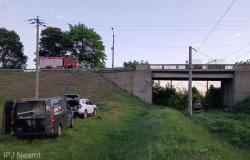
Neglected in the past, when Hunedoara had become a great center of metallurgy in Romania, the Corvinor Castle in Hunedoara came to support part of the city’s economy, while the old factories gradually disintegrated.
Corvinilor Castle now dominates the panorama of Hunedoara. Photo: Daniel Guță. TRUTH
The sharp decline of heavy industry after 1990 deeply affected Hunedoara’s economy, and thousands of people left the city, disappointed, while the city’s factories and mines, which provided their jobs, collapsed one after another.
Unlike other former working-class centers, Hunedoara’s economy benefited from a “lifeline”, neglected for decades, but also from a little “divine help”.
The Corvinor Castle, suffocated by the metallurgical industry
In the 90s, before the first privatizations, restructurings and collective redundancies in mining and steel, Hunedoara still had over 80,000 inhabitants.
Most of the employees worked in the Hunedoara steel plant, at Întreprenea de Construcții Siderurgice (ICSH) and in the iron mines and factories around them, in the neighboring towns of Teliuc and Ghelari.

Image 1/9:
The Corvinian castle in the 90s Photo by peter de graaf
The old center of Hunedoara had then become a place of transit for thousands of commuters who daily entered the gates of the complex or waited for the special bus runs to the factories in Zlasti, Teliuc and Ghelari.
Covered in soot and industrial dust and surrounded by Hunedoara’s most polluting factories (furnaces and coke ovens), Corvinilor Castle in Hunedoara had acquired a greyish-reddish appearance that made it increasingly difficult to distinguish it in the suffocating industrial landscape around it.
“The castle was surrounded on three sides by compound halls, concrete cooling towers, furnaces and rows of towering chimneys spewing acrid, reddish-brown smoke. The color was given by nitrogen dioxide, a toxic gas that forms nitric acid on contact with rain. As the smoke spread, the sky turned pink as if it were always sunset. Along the fourth side of the castle, a noisy funicular carried huge baskets of iron ore directly to the furnaces from a distant mine. It was like falling into some kind of dystopian industrial nightmare or the setting of a post-apocalyptic movie”recounted, on his travel blog, Peter de Graaf, a New Zealand photographer who had visited Hunedoara in the early 90s.
In the 1980s, Corvinilor Castle received about 80,000 tourists annually, many of them students, on excursions or sent to school camps in Hunedoara county.
For some foreign guests, visiting the castle was an interesting experience, but the overall picture of the city looked gloomy, just like other mono-industrial cities.

Image 1/16:
The historic center of Hunedoara and the Corvinilor Castle area Photo Daniel Guță THE TRUTH (80) JPG
“In those days, after paying your entry fee to the castle of 1,000 lei, which is about one New Zealand dollar (no. about 2.7 lei currently), you could go wherever you wanted. There wasn’t much to see in the way of furniture, but there were courtyards, ramparts, great halls, and—best of all—locked doors that creaked open with a firm click, revealing a maze of dark passages and twisting staircases. For some reason, I decided to sleep that night under the stars – not that I could see any through the nitrogen fog – on a grassy knoll near the castle. Maybe I didn’t have much money or maybe I didn’t like my chances of finding a hotel in Hunedoara. All night long the furnaces roared and groaned and threw a fiery glow over the city. It was like a medieval vision of hell“, said Peter de Graaf.
Corvinilor Castle, reborn as a tourist destination
After 1990, the metallurgical plants, factories, funicular facilities and the mining railway gradually disappeared near the Corvinor Castle, and the “purple sky of Hunedoara” (an expression often used in communism) cleared.
Vacant land, littered with industrial ruins, took their place, but in the 2000s, the medieval castle had remained neglected.
Most of the locals were complaining about the loss of jobs and only a few were asking the local authorities and the Romanian state to turn their attention to the historical monument with rotting roofs, through which rainwater was leaking.
The Corvinilor Castle in Hunedoara was cleaned in recent years of the ashes that had covered it for over a century, the roofs of the historical monument were repaired, the surrounding streets were modernized, and from 2019 it entered an extensive restoration process, financed with European funds (video).
The number of tourists has increased from year to year at Corvinilor Castle in Hunedoara, and the surroundings of the monument have been studded with hotels, guesthouses, restaurants and other establishments.
In recent years, more than 400,000 visitors have arrived at Corvinilor Castle in Hunedoara, and without the historical monument, Hunedoara would have been deprived of the annual wave of tourists, but also of several million euros annually brought to the local budget of the municipality, from the visitation fees .
Prislop Monastery attracts thousands of pilgrims
Along with the Corvinor Castle, tourism in Hunedoara received a “divine help” from the Prislop Monastery (video), located about 20 kilometers from the city.
Since the end of the 2000s, the monastic settlement in the country of Hațeg received more and more pilgrims, and many of them stopped in Hunedoara, on their way to the eternal place of the monk Arsenie Boca.
Thousands of people visit the Prislop Monastery in Hunedoara every week, and their number increases during the summer and holidays.
Lake Cinciș from Hunedoara (video) and the villages of the Forest Land, crossed by the mountain roads that start from the old center of Hunedoara, also gave an impetus to tourism in the former working-class town in western Romania.
Tags: glory metallurgy saved tourism medieval castle brings hundreds thousands VIDEO visitors
-




